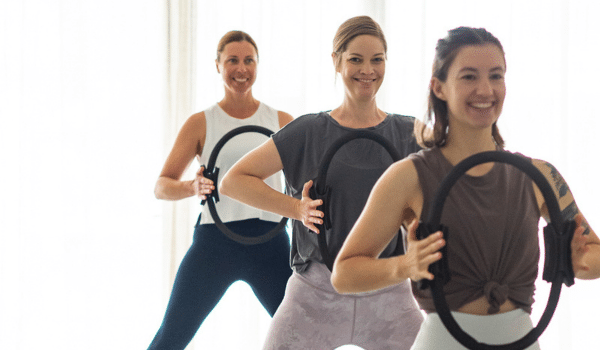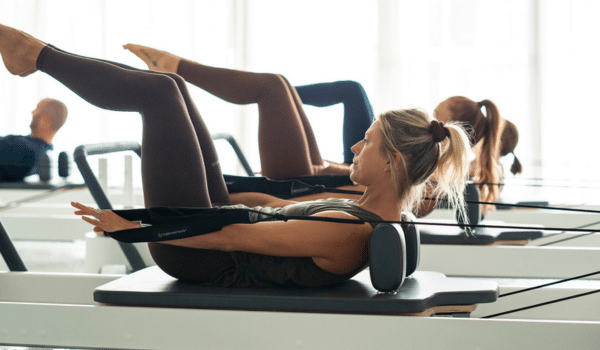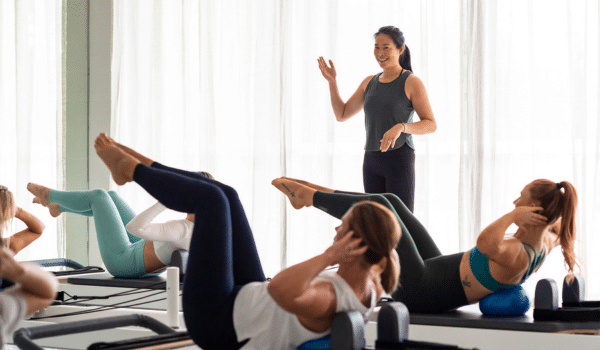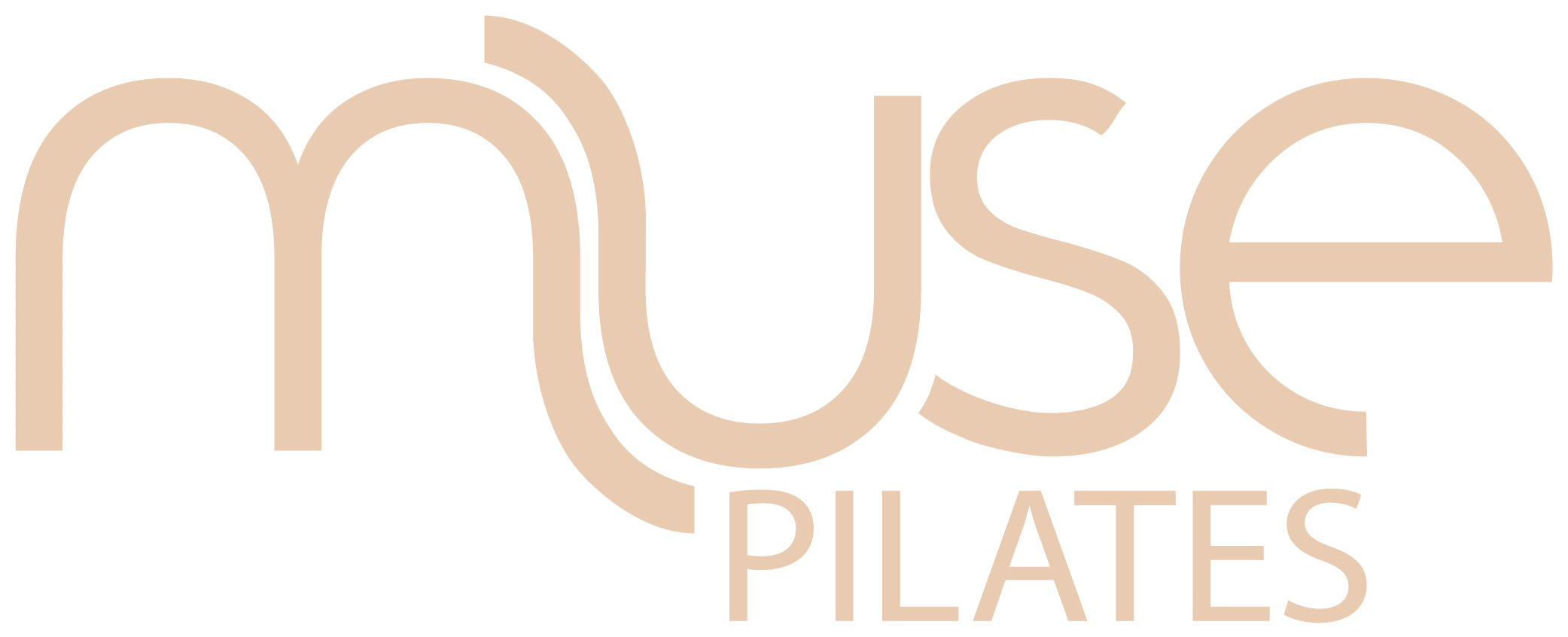Welcome to our comprehensive guide to the fundamentals of Pilates, where we explore some basic principles and techniques that form the core of this joyful practice. Whether you’re a seasoned practitioner or a newcomer to the world of Pilates, understanding the foundational elements is crucial for unlocking the full potential of your workouts.
You’ll need to keep these 4 things in mind whenever you are practising Pilates:
1. Routine
The Overview: Regular practice is essential to ensure your brain and muscles remember the movements and that you’re building strength and flexibility.
- Muscle memory. When you engage in Pilates regularly, your brain and muscles become familiar with the movements, leading to improved muscle memory and overall coordination. Consistency in practice also allows for the gradual development of strength and flexibility, as your body adapts and becomes more efficient in performing the exercises.
- Mind-body connection. A regular routine fosters a deeper mind-body connection, helping you to focus on proper form and breathing techniques, which are fundamental aspects of Pilates. Over time, this mindful approach can lead to enhanced balance, posture, and body awareness.
- Forming good habits. Incorporating Pilates into your routine regularly can contribute to better overall health and well-being. It can help reduce stress, increase energy levels, and promote a sense of inner calm and mental clarity.

2. Spinal Positions
Overview: There are two basic spinal positions in Pilates: Neutral and Imprinted. They can take a little getting used to, and they’re both crucial for engaging in proper Pilates movements and protecting yourself from potential injury.
Neutral Spine
What is it? A neutral spine means that the normal curve of the lumbar spine is present. It refers to the natural and optimal alignment of the spine, where the curves of the lumbar, thoracic, and cervical spine are maintained in their ideal positions.
How do you do it? If you draw an imaginary triangle between your pubic bone and hip bones, that triangle should be parallel to the floor. This alignment helps distribute the load evenly through the spine and pelvis, reducing the risk of strain or injury, and allowing the core muscles to engage more efficiently.
Why is it important?
- Engage the core. In Pilates, maintaining a neutral spine is fundamental to performing exercises with proper alignment and engaging the core effectively.
- Engage stabilising muscles. Maintaining a neutral spine in Pilates not only promotes better posture and spinal health but also allows for the effective engagement of the deep stabilising muscles, such as the transverse abdominis and multifidus. These muscles play a crucial role in providing support and stability to the spine and pelvis during movement, leading to improved strength, flexibility, and overall body awareness.
- Enable better breathwork. A neutral spine encourages better breathing patterns and enhances the mind-body connection, as it promotes a balanced and aligned posture, allowing for more efficient energy flow throughout the body.
Imprinted Spine
What is it? An imprinted spine involves using your abdominal muscles to draw your lower back downward towards the floor.
How do you do it? The concept of an imprinted spine involves using your abdominal muscles to draw your lower back downward towards the floor, which in turn slightly elevates the pubic bone above the hip bones. This position is often used in specific Pilates exercises to engage the core muscles and stabilise the pelvis. Using the imaginary triangle we mentioned above, your pubic bone will be slightly higher than your hip bones.
Why is it important?
- Core strength and stability. The importance of the imprinted spine in Pilates practice lies in its role in promoting core strength, stability, and proper alignment. By consciously engaging the abdominal muscles to create the imprint, you can effectively support the lower back and pelvis, reducing excessive arching and potential strain on the lumbar spine during certain movements.
- Activating deep core musculature. When performing exercises with an imprinted spine, the focus shifts to activating the deep core musculature, including the transverse abdominis and pelvic floor muscles. This engagement contributes to enhanced core stability and can help alleviate discomfort or strain in the lower back, especially for individuals with specific conditions or postural habits that may benefit from this supportive position.
- Mind-body connection. The imprinting action in Pilates can aid in cultivating greater body awareness and control, as it encourages mindful engagement of the abdominal muscles while maintaining a stable and aligned pelvic position. This heightened awareness of core engagement and spinal alignment can translate to improved posture, enhanced functional movement patterns, and a reduced risk of injury during Pilates practice and everyday activities.

3. T-Zone
Overview: Your T-Zone is your Transverse abdominal muscles and your pelvic floor. Correctly engaging the T-Zone during Pilates can help stabilise your muscles, enhance muscle control and reduce your risk of injury.
What is it? The T-Zone in Pilates refers to the area encompassing your Transverse abdominal muscles and your pelvic floor. It is a key focus in Pilates practice as it plays a crucial role in stabilizing the pelvis, supporting the spine, and promoting overall core strength and control.
How do you do it? While lying on your back with your knees bent and your feet hip distance apart, draw an imaginary line horizontally from one hip bone to the other, then a vertical line from your pubic bone to meet the horizontal line. This is your T-Zone. Throughout your entire workout you need to imagine that you are drawing up through your pelvic floor along that vertical line and also draw the hip bones together across the horizontal line.
Why is it important?
- Enhanced stability and control. T-Zone in Pilates lies in its role as the central powerhouse of the body. By actively engaging and strengthening the Transverse abdominals and the pelvic floor, you can enhance stability, support proper posture, and improve overall body awareness. This engagement helps to create a strong and stable foundation for movement, enabling you to perform Pilates exercises with greater control and precision.
- Reduced injury risk. T-Zone activation throughout your Pilates practice can also contribute to improved spinal alignment, reduced risk of injury, and enhanced functional movement patterns.

4. Tabletop Position
Overview: Throughout your Pilates workouts, you will often be told to go into a tabletop position. This refers to a position where you’re lying on your back with your hips and knees bent at 90 degrees. Your knees are directly above your hips and your shins will be parallel to the roof. This will often be your starting position for Pilates exercises.
What is it? The tabletop position in Pilates is a foundational posture where you lie on your back with your hips and knees bent at 90 degrees, creating a shape similar to a tabletop. In this position, your knees are directly above your hips, and your shins are parallel to the ceiling.
Why is it important?
- Engaging the pelvic floor and core. Tabletop helps to engage and stabilise the core muscles, particularly the deep abdominals and pelvic floor. By maintaining this alignment, you can effectively work on strengthening the core and promoting better spinal and pelvic alignment.
- Starting point. Tabletop position serves as a starting point for various Pilates exercises, providing a stable and controlled base from which to initiate movements. It allows for greater awareness of the position of the pelvis and spine, facilitating better body alignment and reducing the risk of strain or injury during exercises.
- Hip mobility. Practising the tabletop position in Pilates can contribute to improved hip mobility and flexibility. By actively holding this position, you can work on enhancing the range of motion in the hip joints, which is essential for many Pilates movements and contributes to overall functional mobility.

Building on Pilates fundamentals
Once you’ve got to grip with the fundamentals, the sky is really the limit with your Pilates practice!
The Muse Pilates Method: Combining Pilates Principles and Community
The Pilates method is a system of exercise and physical movement designed to improve strength, flexibility, posture, and overall body awareness. First developed by Joseph Pilates in the early 20th century, Pilates focuses on the principles of breath, concentration, control, centring, precision, and flow.
At Muse, we’ve built a welcoming and inviting environment where people from every walk of life can experience the life-changing effects of Pilates. It’s all about fun, connection and community.
If you want to learn more about Pilates – and have an amazing time doing it – check out our Pilates classes. We can’t wait to welcome you to your nearest Muse Pilates studio.

